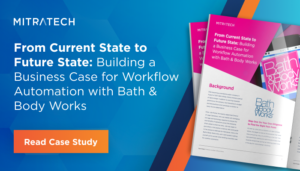Your First 3 Self-Service Workflows According to Rubrik, Micro Focus, and KP Labs [Webinar Recap]
Automation insights from Mitratech’s latest live webinar — Knock Knock: Opening the Legal Front Door to Self-Service Contracting
On Tuesday, December 13th, Mitratech’s Executive Director of Corporate Legal and Claims, Brian McGovern, sat down with executives from Rubrik, Micro Focus, and KP Labs to discuss legal workflow innovation. While our panelists now work with departments of various sizes and maturity levels, they share a common thread.
Sami Najm, Director, Legal at Rubrik, Jessica Vander Ploeg, Vice President of Legal Operations at Micro Focus, and Tarryn Puzsar, Director of Business Process Automation at KP Labs, previously worked together at NetApp; a long-time advocate of TAP, trusted partner of Mitratech, and a prominent proponent of workflow automation.
Now, all three implement workflow innovation within different environments — Sami’s 20-person legal department, for example, is split evenly between the commercial legal and corporate legal side to serve Rubrik’s 2,500+ employee base. Meanwhile, Jessica’s 50-person legal department operates with six functions — with commercial legal by far the biggest — to serve over 11,000 Micro Focus employees.
The best practice these two departments and executives have in common? Legal workflow automation. Tarryn kicked off the conversation with a look at why self-service tools are transcending industries, functions, and business models.
“Teams are looking for efficiencies and striving to make their lives easier. So, there’s this big question of how do we transform the mundane – how do we increase our efficiency? And process automation seems to be it. It really is on the forefront of everyone’s minds — how they can make their lives more streamlined through something like a legal front door.” –Tarryn Puzsar, Director of Business Process Automation, KP Labs
Get a recap of the webinar highlights below. You can also watch the full webinar replay here.
A Quick Recap: What is a Legal Front Door?
A legal front door is a legal service request portal that replaces the frenzy of chats, emails, and one-off questions and instead directs anyone seeking legal advice toward the same outreach channel. Here, they can be prompted for routine request types (contract templates) or pre-answered FAQs (like “what’s our policy for___…”). For example, suppose a requester is looking to start a contract; In that case, all the required information is gathered up front (company, address, state, parties involved, etc.) before it’s ever sent to legal, replacing the back and forth for information.
Employees can use legal request portals across the organization for things like sales contracts, vendor agreements, or just general legal questions. On the back end, legal request portals are a look into the workload of legal staff, providing valuable data on how long processes take, where bottlenecks arise, or when staffing gaps occur.
As Tarryn explains, a legal front door is a portal that allows organizations to work closely with legal while also enabling self-sufficiency:
“You enable multiple teams to come in and work on contracts, and there’s also the self-service element that becomes incredibly important when we talk about these hundreds of emails in our inboxes. How many email requests do you think you could take out and put in a self-service process?” –Tarryn Puzsar, Director of Business Process Automation, KP Labs
When used correctly, legal request portals funnel and triage requests for faster time-to-value, streamlined drafting and review, organized document management, and self-service legal advice. Additional benefits of a legal front door include:
- Rich metrics on request types, workloads, etc.
- Data-driven process improvements
- Cost savings
So, what kind of processes should you be automating? As Jessica recommends, look for high-volume, low-complexity tasks. Or better yet, look for where you can make the most impact.
“Where can we make the most measurable difference? Either in total volume, in ROI, or just in value to the business” – Jessica Vander Ploeg, Senior Director of Legal Operations at Micro Focus.
Rubrik, Inc. was actually named the winner of Corporate Counsel’s “Best Use of Technology” Award, recognized for demonstrated innovation in using TAP, Mitratech’s workflow automation solution, to transform the legal intake process. Within the first 60 days of launching TAP, the Rubrik team used their self-service legal front door to resolve 68 admin requests, including sending contract templates, certificates of insurance, answering FAQs, etc. Fielding those requests used to take a team member about 5 minutes each, so in the first two months, Rubrik was able to save about 6 hours on admin work— a number they anticipate will only increase.
“It made the most sense to focus on what my day-to-day looked like and where I could help my team save time” — Sami Najm, Director, Legal at Rubrik
Despite their difference in size, Rubrik, Micro Focus, and KP Labs all agreed on the top three self-service workflows legal ops professionals can begin leveraging today to elevate their operations.
Your First Three Self-Service Workflows
1. NDAs
During our live discussion, nearly half of the legal ops leaders in attendance reported wanting to automate the NDA process — which came as no surprise to our panelists. As Tarryn explains, the ability to convert paper copies and internal back-and-forth into an automated, streamlined process with a pre-signed template saves everyone time and money.
“Self-service NDAs are definitely one of the workflows that can provide the most wins — not only in ROI, but also internally. It’s just such a high-volume workflow — and the metrics you can capture on them are phenomenal.” – Tarryn Puzsar, Director of Business Process Automation, KP Labs
Like many companies, Micro Focus had an email inbox that was creating internal havoc when it came to managing NDAs. As the team came to the end of the fiscal year, it needed a way to easily filter and streamline the requests.
“Our commercial team was drowning, and we were able to take on that inbox. Then, we could use that data and knowledge to build something automated. – Jessica Vander Ploeg, Vice President of Legal Operations at Micro Focus
2. Evaluation Agreements
In their early days of working together in legal operations, Tarryn and Sami initially found that their highest-volume, most repetitive requests were evaluation agreements. Why did it require a human touch to send the same information over and over again for each agreement? Well, it shouldn’t have.
“This was an easy, low-hanging fruit for us that opened the door for automating more agreements. The instant feedback we got was that the lack of human touch after we automated our evaluation agreements really sped up the contracting process for the sales team. And from the commercial side, the sales team loved that their sales cycle shrunk as the legal team got these agreements out faster and reduced churn.” — Sami Najm, Director, Legal at Rubrik
3. Privacy-Based and Procurement Agreements
For Jessica at Micro Focus, privacy-based and procurement workflows were having a major impact on business customers — especially legal. In these workflows, requesters submit details like supplier and transaction information, involved parties, and agreement criteria. The workflow can then dynamically set contract terms, include clauses based on pre-approved and pre-determined criteria, then send for e-signature. This allows Micro Focus to build and execute contracts faster, gathering all required information up front and generating contracts specific to each vendor’s needs.
Privacy-based and procurement workflows go beyond accelerating operations for Micro Focus; once the contracts are executed and signed, metadata can be extracted from the centralized data repository.
“One has high ROI, the other has a high governing ability, which we’ve found, even if there’s a low-volume workflow or ROI isn’t great, high governance or automobility is beneficial.” – Jessica Vander Ploeg, Vice President of Legal Operations at Micro Focus.
Digging into the Self-Service Data
Beyond reducing the sales cycle and cutting back-and-forth email communications, another layer of workflow ROI comes from in-process analytics, which allows you to make more data-driven decisions. For example, Rubrik has been leveraging its automation metrics to make smarter hiring, workload allocation, and management moves. The team now has data on where every request is coming from — every front door ticket captures who that person is, their organization, their manager, their cost center, geography, etc.
“When someone asks, ‘hey, where’s the bulk of your work coming from – do I need to hire in Europe or Asia? Do I need more people doing More NDAs or complex agreements?’ Those answers used to be in a black box that would make great guesses on, but now our General Counsel can go into the dashboard and say, ‘yes, we need this, and here’s the data from the past year to back that up.'” — Sami Najm, Director, Legal at Rubrik
Ready to take the first step towards automation? Learn more about our partnership with KP Labs here: https://mitratech.com/partners/wfa/kp-labs/.




